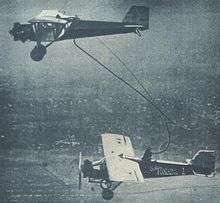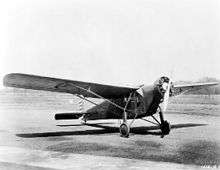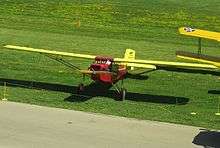Curtiss Robin
| Curtiss Robin | |
|---|---|
| | |
| A Curtis Robin in the Seattle museum of flight, 2011 | |
| Role | Touring |
| Manufacturer | Curtiss-Robertson Airplane Manufacturing Company |
| First flight | August 7, 1928[1] |
| Introduction | 1928 |
| Status | A number still flying[1] |
| Primary user | U. S. Private Owner Market[1] |
| Number built | 769[1] |
| Unit cost |
$7,500 U.S. Dollars (1938) |
The Curtiss Robin, introduced in 1928, was a high-wing monoplane with a 90 hp (67 kW) V8 OX-5 8-cylinder engine built by the Curtiss-Robertson Airplane Manufacturing Company. It was later fitted with the more powerful Challenger engine, which developed between 170 and 185 hp (127 and 138 kW). NOTE: Model B (90 hp/67 kW Curtiss OX-5 engine), Model C-1 (185 hp/138 kW Curtiss Challenger engine), and Model J-1 (165 hp/123 kW Wright J-6 Whirlwind 5 engine)
The J-1 version was flown by Douglas Corrigan (nicknamed "Wrongway") as well as The Flying Keys.
Design
The Robin, a workmanlike cabin monoplane had a wooden wing and steel tubing fuselage. The cabin accommodated three persons; two passengers were seated side-by-side behind the pilot. Early Robins were distinguished by large flat fairings over the parallel diagonal wing bracing struts; the fairings were abandoned on later versions, having been found to be ineffective in creating lift.[1] The original landing gear had bungee rubber cord shock absorbers, later replaced by an oleo-pneumatic system; a number of Robins had twin floats added.
The plane's payload with 50 gal (189 l) of fuel was 452 lb (205 kg); it had a cruising speed of 102 mph (164 km/h), a landing speed of 48 mph (77 km/h), a gas capacity of 50 gal/189 l (25 gal/95 l in each wing tank), its oil capacity was 5 US gal (19 l; 4 imp gal). The aircraft's price at the factory field was $7,500.
Operational history

A single modified Robin (with a 110 hp (82 kW) Warner R-420-1) was used by the United States Army Air Corps, and designated the XC-10. This aircraft was used in a test program for radio-controlled (and unmanned) flight.[2]
Cuba's national airline, Compañía Nacional Cubana de Aviación Curtiss, was founded in 1929 with Curtiss Aircraft serving as its co-founder and major investor. The airline's first aircraft was a Curtiss Robin; it flew domestic routes as a mail and passenger transport.
From September 1929 to May 1930, a Robin C-1 was used to deliver the McCook, Nebraska Daily Gazette to communities in rural Nebraska and Kansas. The airplane flew a nonstop route of 380 miles (610 km) daily, dropping bundles of newspapers from a height of 500 feet (150 m) to local carriers.[3][4]
A Curtiss Robin C was purchased by the Paraguayan government in 1932 for the Transport Squadron of its Air Arm. It was intensively used as a VIP transport plane and air ambulance during the Chaco War (1923–1935).
Variants
- Challenger Robin
- An early version of the Robin, powered by a 165 hp (123 kW) Curtiss Challenger radial piston engine.
- Comet Robin
- One Robin was converted by its owner in 1937, it was fitted with a 150 hp (112 kW) Comet radial piston engine.
- Robin B
- A three-seat cabin monoplane, fitted with wheel breaks and a steerable tailwheel; about 325 were built.
- Robin B-2
- This was a three-seat cabin monoplane, powered by a number of Wright piston engines.
- Robin C
- Three-seat cabin monoplane, powered by a 185 hp (138 kW) Curtiss Challenger radial piston engine; about 50 built.

- Robin C-1
- An improved version of the Robin C, powered by a Curtiss Challenger radial piston engine; over 200 built.
- Robin C-2
- A long-range version fitted with an extra fuel tank, it was powered by a 170-hp (127 kW) Curtiss Challenger radial piston engine; six built.
- Robin 4C
- The four-seat version, powered by a Curtiss Challenger radial piston engine; one built.
- Robin 4C-1
- Three-seat version with an enlarged forward fuselage section; three built.
- Robin 4C-1A
- Another four-seat version with an enlarged forward fuselage section; 11 built.
- Robin CR
- One-off experimental version, fitted with a 120 hp (90 kW) Curtiss Crusader engine; one built.
- Robin J-1
- It was powered by a 165 hp (123 kW) Wright Whirlwind J-6-5 radial piston engine; about 40 built.
- Robin J-2
- A long-range version, fitted with an extra fuel tank; two built.
- Robin M
- The Robin B aircraft, fitted with the 115 hp (86 kW) V-502 engine.
- Robin W
- It was powered by a 110 hp (32 kW) Warner Scarab radial piston engine. Only a small number were built in 1930.

- XC-10
- One Robin W was sold to the United States Army Air Corps, it was converted into an unmanned pilotless radio-controlled test aircraft.
Operators
Military operators
Survivors

- Kermit Weeks has restored a Curtiss Robin to flying status and it is on display at Fantasy of Flight in Polk City, Florida.[5]
- An apparently airworthy Robin J-1, registered VH-JUV, is at Gawler, South Australia.[6]
- Western Antique Aeroplane & Automobile Museum has an OX-5 powered Robin.[7]
- Evergreen Aviation & Space Museum has a Continental R670 powered Robin.[8]
- EAA AirVenture Museum has a V-502 powered B-2 [9]
- Western North Carolina Air Museum has a Continental R-670 powered Robin on display.
- Museu TAM has a Jacobs R-755-A1 L-4MB powered Curtiss-Robin C-2 [10] on display
- Yanks Air Museum in Chino, CA has a fully restored R-600 Challenger powered Curtiss Robin C-1 N3865B on display.[11][12]
A Curtiss Robin is based at Old Rhinebeck Aerodrome and flies during weekend airshows.
- Air Zoo A Curtiss Robin with OX5 is on display at the Air Zoo museum in Portage, MI
A Curtiss Robin is exhibited on floats at the cradle of Aviation Museum, Garden City, N.Y.
Specifications (Robin OX-5)
Data from Curtiss Aircraft 1907–1947 [13]
General characteristics
- Crew: one
- Capacity: two passengers
- Length: 25 ft 8½ in (7.83 m)
- Wingspan: 41 ft 0 in (12.49 m)
- Height: 7 ft 9½ in (2.37 m)
- Wing area: 223 ft² (20.71 m²)
- Empty weight: 1,472 lb (668 kg)
- Loaded weight: 2,440 lb (1,107 kg)
- Powerplant: 1 × Curtiss OX-5 liquid-cooled V-8, 90 hp (67 kW)
Performance
- Maximum speed: 100.5 mph (87 knots, 135 km/h)
- Cruise speed: 84 mph (73 knots, 135 km/h)
- Range: 480 mi (432 nmi, 772 km)
- Service ceiling: 10,200 ft (3,109 m)
- Rate of climb: 400 ft/min (2.0 m/s)
See also
- Related development
- Related lists
References
- Notes
- 1 2 3 4 5 Eden, Paul and Soph Moeng. The Complete Encyclopedia of World Aircraft (cover). London: Amber Books Ltd., 2002, ISBN 0-7607-3432-1.
- ↑ Bowers 1979, pp. 385–386.
- ↑ "Curtiss-Robertson Robin C-1". Museum of Flight. Retrieved 2013-06-24.
- ↑ Discoe, Connie Jo. "'News Boy' pilot was aviation pioneer". McCook Daily Gazette. 2008-12-27. Retrieved 2013-06-24.
- ↑
- ↑ Bezmylov, Andrei. "Robin J-1." airliners.net, 2006. Retrieved: July 16, 2010.
- ↑ "1929 Curtiss Robin." Western Antique Aeroplane & Automobile Museum.
- ↑ "Curtiss Robin B." Evergreen Aviation & Space Museum.
- ↑ "Curtiss-Wright Model B-2 Robin - N50H." EAA AirVenture Museum.
- ↑ "Curtiss-Robin C2" EAA AirVenture Museum.
- ↑ "Yanks Search Results". yanksair.com. Retrieved 2016-09-08.
- ↑ "FAA Registry - Aircraft - N-Number Inquiry". registry.faa.gov. Retrieved 2016-09-08.
- ↑ Bowers 1979, p. 385.
- Bibliography
- Bowers, Peter M. Curtiss Aircraft 1907–1947. London: Putnam, 1979. ISBN 0-370-10029-8.
External links
| Wikimedia Commons has media related to Curtiss Robin. |
- Virginia Aircraft Museum
- Airminded.net
- Information about this flight at the National Air and Space Museum Web Site
- Curtiss Robin at Museum of Flight
- A Curtiss Robin is rebuild from an empty frame
- A brief story of "Wrongway" Corrigan's adventure